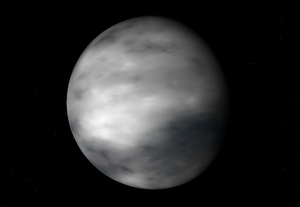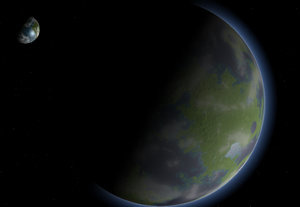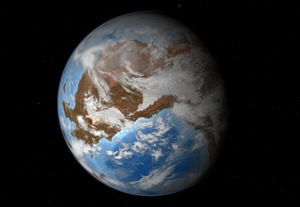Zeta (1) Reticuli
| Zeta (1) Reticuli | |
| Stellar characteristics | |
|---|---|
| Constellation | Reticulum |
| Right ascension (Epoch J2000) | 03h 17m 46.20s |
| Declination (Epoch J2000) | -62° 34' 31.20" |
| Spectral type | G2.5-5 V |
| Distance from Sol | 39.5 ly |
| Other designations | Valinor, Zet1 Ret, HR 1006, Gl 136, Hip 15330, HD 20766, CP(D)-63 217, SAO 248770, LHS 171, LTT 1573, LFT 275, LPM 146 |
| Planets | Elemmire, Earendil, Arda, Carnil, Alcarinque, Lumbar, Nenar, Lunil, Morgoth |
The Zeta (1) Reticuli (Zeta1 for short) consists of nine IAU-standard planets, a debris belt between planets six and seven, an asteroid belt between planets four and five, plus the usual assortment of dwarfs, comets and other out-system debris. Navigation through the outer debris belt is slightly trickier than normal outer system navigation around Sol, and routes charting above the local ecliptic are recommended. The star's Cochrane line lies at 38 AU, though this may be disrupted by the outermost planet.
The system was first surveyed by the Sozvezdie Soviet Deep Space Exploration Force in 2013, as a consequence of discovering and activating the Tannhauser Gate stargate in the Delta Pavonis system. This makes it the first star system that was reached by humans by a stargate rather than by a normal-space trip.
Stellar Characteristics
The system is part of a wide-binary system, along with Zeta (2) Reticuli (currently located roughly 3,750 AUs away), and is located roughly 39.5 light-years from Sol. On Earth, it can be seen in the west-central part of the constellation Reticulum, the Reticule or Net (an old astronomical instrument used to measure star positions).
The star is a yellow-orange main sequence dwarf star slightly smaller than Sol (with roughly 93% of Sol's mass, 91% of its diameter, and 79% of its luminosity). Zeta (2) Reticuli is brighter than Zeta (1). The two stars have common proper motion and equal radial velocities, making them a permanent pair, not a chance co-location of stars. The pair is believed to be part of the "Zeta Herculis" stellar moving (kinematic) group of high velocity stars (which no longer includes Zeta Herculis).
Current 'danelaw astrophysics believes the Zeta Reticuli pair are likely to be as much as eight billion years old.
The Planetary System
Elemmire
Elemmire is a small Mercury-type planet with a dense iron core and not much else to speak of.
Earendil
A warm terrestrial world covered almost entirely by deep ocean, Earendil resembles in some ways the popular conception of Venus before the beginning of the space age. It would probably be considered a paradise save for the extremely dense atmosphere consisting of mostly nitrogen and helium with only 3% free oxygen.Interestingly enough, at 4.1 bar (the rough atmospheric pressure at sea level on Earendil) the mixture of nitrogen, helium and oxygen present in the atmosphere is breathable by humans and other Earth-adapted life. It's not a pleasant experience by any means, but it is doable. To date, however, this remains a largely theoretical exercise, since nobody really wants to try it.
Arda
Arda is a very Earthlike world. Slightly larger but not as dense as Earth and roughly the same water/land ratio, the planet supports a robust biosphere with abundant plant and animal life everywhere.[1]
Valinor
According to everything known about planetology, something like Valinor cannot happen naturally. A moon the size of Valinor doesn't have the mass necessary to maintain a core hot enough to generate a magnetic field, nor is that mass enough to hold onto volatiles like free oxygen, nitrogen and water. And research into Valinor bears this out – the moon was terraformed within the last 30,000 years, given an artificial magnetosphere though a process similar to the Xavier Protocol satellites used by the Mars Terraforming Project, and populated with lifeforms from Arda[2]. Who did this, and why, remain a mystery. No signs of indigenous intelligent life or extraterrestrial colonization were found on Arda, Valinor nor any of the other planets in the Zeta1 system. The current hypothesis suggests that the system was discovered and then terraformed by automated probes, which upon completion of their work departed for another system.
Night's Door
The companion to Tannhauser Gate, the artificial wormhole aperture holds position at the L1 point between Arda and Valinor. It appears to be identical in structure to the one in Delta Pavonis, with the same mixture of metal, transuranics and inert handwavium.
Interestingly enough, 'handshaking' with the control system inside Night's Door revealed a more complex system than the one inside Tannahuser. Soviet research suggests that Night's Door may be able to connect to other apertures than just Tannhauser. Research is still continuing.
Carnil
The last of the inhabitable worlds in the Zeta1 system. Carnil is largely Earthlike, covered with large shallow oceans and extensive mountain ranges. Unlike Earendil, Arda and Valinor, life on Carnil hasn't really developed past the algae-and-fish stage; the continental masses are largely uncolonized, while the oceans have extensive biospheres based on subsurface mats of kelplike plants.Alcarinque
The largest gas giant in the Zeta1 system, Alcarinque is a pretty average Jupiter-type world, notable only by its ring system, which is larger and more extensive than Saturn's.
Lumbar
Another gas giant, again nothing really exciting about it.
Nenar
A Neptunian ice dwarf with a larger than normal number of moons for a planet of its mass, but otherwise nothing special in composition.
Lunil
Another ice dwarf with nothing particularly special about it.
Morgoth
Last of the ice dwarfs in the Zeta1 system, and the smallest of the three. Has one moon, Sauron, that gets enough tidal energy from Morgoth to have extensive volcanic activity on the surface, raising the local temperature to above the freezing point.
Notes
- Jump up ↑ In at least one Fenspace Infinity, the VVS establish their largest city, Osgiliath, here.
- Jump up ↑ According to genetic comparison research done on samples provided to the Vesta Institute of Biochemistry.


